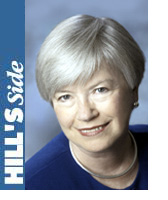In February, we kicked off our year of Hopkins Nursing Milestone celebrations with a timely and topical event that explored the converging crises of the aging of America and the nationwide shortage of nurses. Who Will Care for Us?, a public symposium sponsored by the School of Nursing, brought to Hopkins—and to the issue—the celebrity of ABC-TV News Correspondent Sam Donaldson and the expertise of noted social marketing expert AARP Chief Executive Officer Bill Novelli and the Hartford Foundation’s Claire Fagin. I had the honor of joining Bill and Claire on a panel moderated by Sam, who generously waived his speaking fees in honor of the occasion and the issue. For two exhilarating hours, before an audience that filled the School of Nursing Alumni Auditorium, we grappled with the realities of the graying of America and the impact that national demographics will have on our future health care.
celebrations with a timely and topical event that explored the converging crises of the aging of America and the nationwide shortage of nurses. Who Will Care for Us?, a public symposium sponsored by the School of Nursing, brought to Hopkins—and to the issue—the celebrity of ABC-TV News Correspondent Sam Donaldson and the expertise of noted social marketing expert AARP Chief Executive Officer Bill Novelli and the Hartford Foundation’s Claire Fagin. I had the honor of joining Bill and Claire on a panel moderated by Sam, who generously waived his speaking fees in honor of the occasion and the issue. For two exhilarating hours, before an audience that filled the School of Nursing Alumni Auditorium, we grappled with the realities of the graying of America and the impact that national demographics will have on our future health care.
We asked the questions, we submitted solutions, and we became united in our commitment to addressing the issue. Yes, we can attract the brightest and the best to the nursing profession. Yes, we can train them in the newest technologies. And yes, the salaries today are more competitive and are ensuring that nursing is now a career destination. But throughout this Milestone event and every day before and since, a less examined question lurks in the wings, creating a sub-plot that threatens our commitment: How will we fill the faculty positions to train those who will care for us?
Typically, we avoid that question and instead focus on the good news: A recent article in the Johns Hopkins Medicine newspaper, the Dome, heralded the decrease in nursing shortages at Hopkins Hospital. Our winter career day here at SON was packed with employers looking for Hopkins nurses. Registered nurses now rank #1, in the U.S. Bureau of Labor Statistics’ top 10 occupations with the largest projected job growth for the years 2002 to 2013, and the American Association of Colleges of Nursing reports enrollments in entry-level baccalaureate programs are soaring after years of steady decline in the late 1990s. Our applications at SON increased 21 percent this year!
We applaud these good news stories, but each impacts the very foundation of the nursing profession: Those who train those who care for us. Nursing enrollments are up, but more than 11,000 qualified applicants had to be turned away because of insufficient numbers of faculty, classrooms, and clinical sites. Nationwide, recruitment of qualified, well-trained, and dedicated faculty and master’s-prepared clinical preceptors verges on the cut-throat, but faculty positions are not competing with the attractive salaries, signing bonuses, and reduced hours now offered by hospitals, and other employers. And, compounding the problem, the graying of America finds too many of us—the current trainers—approaching retirement age with too few waiting to take our places. Today the traditional pipeline for our replacements is narrowed by obstacles to continued training for baccalaureate nurses: rising tuition, reduced state and federal education assistance, and burgeoning educational debt loads.
For those of us at the SON, these are the factors that drive us every day and form the very basis of our planning strategies for the next three years:
- To enhance excellence in research, teaching, and practice.
- To cultivate an environment that embodies the School of Nursing values of excellence, respect, diversity, integrity, and accountability.
- To position Johns Hopkins Nursing internationally as a leader in nursing and health care.
- To achieve planned growth that is strategically driven, innovative, and financially sound.
I urge each and every one of you to join us in our dedication to reaching those goals and to ensuring that the answers to “Who will train those who care for us?” will be new milestones for our future celebrations of Hopkins Nursing.
Martha N. Hill, PhD, RN, ’64 Dean
